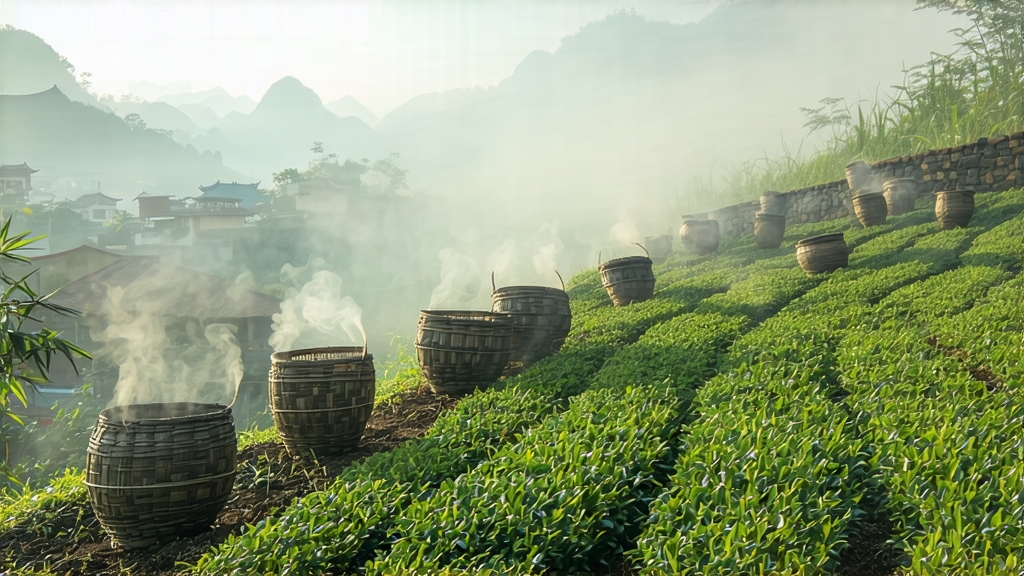
Tucked away in the humid, karst-veined mountains of southern China’s Guangxi Zhuang Autonomous Region, Liu Bao 六堡茶 is the quietest celebrity of the dark-tea family. While Pu-erh commands auction headlines and Fu bricks dazzle with their golden “flowers,” Liu Bao has spent four centuries perfecting the art of discretion, aging in bamboo baskets, traveling on the backs of horses and coolies along the Tea-Horse Road’s southern spur, and steeping itself into the bloodstreams of dockworkers, opera singers, and, more recently, a new generation of global tea aficionados who crave depth without drama.
Historical footprints
The first written record appears in 1620, when the Cangwu County Gazetteer noted that “dark tea from Liu Bao village relieves dampness and counters miasma.” Traders from Guangdong and Hong Kong discovered that the tea not only survived the sweltering river journey down the Xi Jiang system but actually improved, its rough edges planed smooth by the heat and humidity of cargo holds. By the late Qing, Liu Bao was ballasted into the holds of ocean junks bound for Southeast Asia where tin-mine coolies swore it prevented beriberi and “cooled the blood.” In 1886 the British colonial medical journal for Malaya listed “Liu-pu” (a romanization twist) as a recommended prophylactic against malaria, inadvertently creating the first export health fad. When the Communist era collectivized tea gardens in the 1950s, Liu Bao became one of China’s designated “border-sale teas” (边销茶), bartered for cattle and wool with minority peoples along the southwestern frontier. Only after 2008—when the Guangxi government applied for National Geographic Indication status—did specialty cafes from Berlin to Brooklyn begin asking, “If Pu-erh is the king of dark tea, why does Liu Bao feel like the emperor’s hidden twin?”
Micro-terroirs within one name
Liu Bao is not a single garden but a constellation of micro-climates clustered around the town of Liubao in Wuzhou prefecture. The three most celebrated sub-zones are:
- Tangping 塘坪: 350–450 m elevation, red lateritic soil rich in iron oxide, giving a cocoa-like base note.
- Xianren 仙人: literally “Immortal’s Peak,” 550–650 m, shrouded in cloud until 10 a.m.; leaves here develop higher amino acids, translating into a sweet, almost orchid finish after aging.
- Heishi 黑石: “Black Rock,” named for basalt outcrops that radiate afternoon heat, stressing bushes into producing thick, wax-cuticular leaves ideal for decades-long maturation.
Each zone traditionally supplied its own village workshops, so pre-1950 cakes often carried ink-brush labels such as “Old Song of Tangping” or “Heishi Night Fragrance,” antiques now hunted by Guangzhou tea brokers.
Leaf architecture and cultivar genetics
The local population is a Camellia sinensis var. sinensis landrace called “Wuzhou medium-leaf,” characterized by an oval blade, 7–9 cm long, with 28–32 serrations per margin and a purple dorsal vein when mature. Its polyphenol oxidase activity is 18 % higher than Yunnan Daye, the broad-leaf parent of Pu-erh, explaining why Liu Bao can endure the intense wet-piling process without collapsing into mulch. Farmers still use a 300-year-old selection criterion: if a picked shoot bends 90° without snapping and the petiole exudes a milky latex, it is “Liu Bao material”; otherwise it is diverted into green-tea channels.
Crafting darkness: from shaqing to “basket-fermentation”
Although Liu Bao is classified as a post-fermented dark tea, its production is a two-act drama: primary kill-green and rolling, then a secondary microbial opera inside bamboo baskets.
Act 1 – Fixing and rolling
Fresh leaves are withered 3–5 hours on bamboo mats until they lose 12 % moisture, just enough to soften cell walls. A uniquely short shaqing (kill-green) of 2–3 minutes at 160 °C follows—shorter than most green teas—preserving oxidative enzymes that will later collaborate with microbes. Rolling is done on 120-year-old camphor-wood tables whose resin imparts a faint medicinal note. After a brief 30-minute